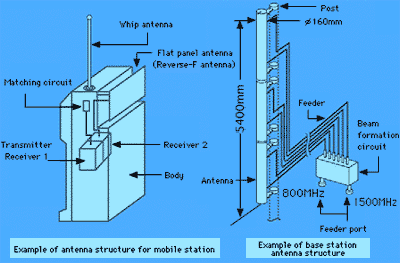Antennas, Base and Mobile Stations -1.Mobile Communications Antennas
Antennas serve as the information gateways for mobile radio communications systems. Because of this, they must have the performance and functions capable of dealing with the characteristics of mobile communications, the limitations imposed by the radio wave environment and radio systems, changes in the surrounding environment, and the influence of nearby objects.
There are various types of antenna, including linear antennas, board-shaped antennas, aperture antennas, and array antennas that combine these various elements. Linear antennas have the simplest structural element and constitute the basic antenna form. This type of antenna is mainly used as an element in base-station array antennas. Antennas that employ board-shaped elements include board-shaped reverse-F antennas, parallel flat-board antennas and board-shaped dipole antennas.
An array antenna involves multiple antenna elements arranged in alignment. By changing the power supply phase and amplitude of each element, an array antenna is capable of sharpening directivity and pattern forming.

Outline of Mobile Communications Antennas
![]() Created 1999/03
Created 1999/03
